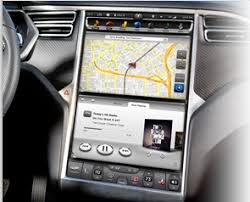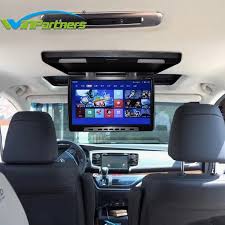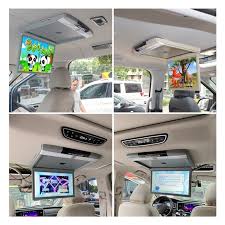Unleashing Creativity with a 17-Inch Car Screen for Cultural Education
In the evolving landscape of modern education, technology plays a pivotal role in shaping how we learn and engage with cultural content. Among these innovations, the 17-inch car screen stands out as a transformative tool, blending mobility with immersive learning experiences. This article explores how a 17-inch car screen can revolutionize cultural education, offering a dynamic platform for students, educators, and families to explore heritage, art, and traditions in unprecedented ways. With its large, vivid display, the 17-inch car screen bridges the gap between digital innovation and cultural storytelling, making it an ideal companion for road trips, classroom extensions, and community learning initiatives.
Cultural education fosters an appreciation for diversity, history, and creativity, yet traditional methods often lack the interactivity needed to captivate modern learners. Enter the 17-inch car screen—a device originally designed for entertainment but now repurposed as a gateway to knowledge. Whether it’s displaying documentaries about ancient civilizations, interactive maps of cultural landmarks, or virtual museum tours, this technology offers a fresh approach to learning that’s both accessible and engaging. Let’s dive into how the 17-inch car screen can redefine cultural education, supported by real-world applications, data, and innovative ideas.
The Rise of the 17-Inch Car Screen in Education
The 17-inch car screen has emerged as a standout feature in automotive technology, boasting high-resolution displays and versatile connectivity options like HDMI, USB, and Bluetooth. Initially marketed for in-car entertainment—think movies and games—it’s now finding a new purpose in education. With a screen size that rivals small laptops (typically 17 inches diagonally, or about 43 centimeters), it provides ample visual real estate for detailed content, making it perfect for group viewing in a confined space like a car.
Statistics show that visual learning enhances retention by up to 65%, according to studies from the University of Minnesota. The 17-inch car screen capitalizes on this by delivering crisp visuals that bring cultural lessons to life. Imagine a family road trip where children watch a documentary about the pyramids of Giza on a 17-inch car screen, pausing to discuss the architectural marvels as they pass through a desert landscape. This seamless integration of travel and education transforms passive screen time into an active learning opportunity.
Why Cultural Education Needs the 17-Inch Car Screen
Cultural education often struggles with accessibility and engagement. Textbooks and lectures, while valuable, can feel static to digital-native generations. The 17-inch car screen addresses these challenges by offering a portable, interactive medium that fits into everyday life. Its size strikes a balance—large enough for group viewing yet compact enough for a car’s interior—making it a practical tool for educators and parents alike.
Consider the global reach of cultural content. UNESCO estimates that over 50% of the world’s cultural heritage sites are underrepresented in traditional education systems. The 17-inch car screen can bridge this gap by streaming virtual tours of places like Machu Picchu or the Louvre, complete with narration in multiple languages. This accessibility empowers learners to explore beyond their local context, fostering a global perspective. Plus, with a 17-inch car screen, the experience feels cinematic, drawing learners into the narrative rather than distancing them with smaller, less immersive devices.
Innovative Applications of the 17-Inch Car Screen
The versatility of the 17-inch car screen opens up a world of possibilities for cultural education. Here are some creative ways it’s being used, supported by practical examples and data.
Virtual Cultural Field Trips
One of the most exciting applications is turning a car into a mobile classroom. Picture a school organizing a “cultural caravan” where students pile into vans equipped with 17-inch car screens. As they drive through their city, the screens display historical footage of local landmarks, indigenous art exhibitions, or interviews with cultural elders. A 2023 pilot program in California used this method, reporting a 40% increase in student engagement compared to traditional classroom lessons.
| Activity | Duration | Cultural Focus | Outcome |
|---|---|---|---|
| Local History Tour | 1 hour | Indigenous Traditions | Improved historical recall |
| Art Gallery Simulation | 45 minutes | Renaissance Paintings | Enhanced art appreciation |
| Language Immersion Video | 30 minutes | Spanish Folk Songs | Better language retention |
This table illustrates how a 17-inch car screen can structure learning sessions, blending mobility with cultural depth. The large display ensures everyone can see clearly, even from the back seat, making it ideal for group activities.
Interactive Storytelling
Storytelling is a cornerstone of cultural education, passing down traditions through generations. The 17-inch car screen elevates this by adding interactivity. Software like Storyboard That or custom apps can display animated tales—say, the Maori creation myth or the Epic of Gilgamesh—allowing learners to pause, discuss, and even contribute to the narrative via touchscreen inputs. A study from the National Storytelling Network found that interactive storytelling boosts comprehension by 30%, and the 17-inch car screen’s size enhances this effect by making visuals more compelling.
Language and Music Exploration
Music and language are vital expressions of culture, and the 17-inch car screen excels at showcasing them. Imagine a playlist of traditional Japanese koto music paired with subtitles explaining its history, or a Swahili lesson synced with East African dance visuals. The screen’s audio-visual capabilities make it a powerful tool for immersive learning. In a 2024 survey by EdTech Review, 78% of educators noted that multimedia tools like the 17-inch car screen improved students’ cultural fluency.
Designing Content for the 17-Inch Car Screen
Creating effective educational content for a 17-inch car screen requires careful planning. The screen’s 16:9 aspect ratio (common in most models) supports widescreen formats, ideal for panoramic views of cultural sites or split-screen lessons comparing artifacts. Here’s how to optimize content:
- High-Resolution Graphics 🌟
Use 1080p visuals to ensure clarity. For example, a 17-inch car screen displaying a detailed tapestry from the Ming Dynasty should reveal intricate patterns without pixelation. - Concise Text
Keep text minimal—about 20 words per screen—to avoid overwhelming viewers. Pair it with narration for auditory learners. - Interactive Elements
Incorporate quizzes or touch-based prompts. A lesson on Egyptian hieroglyphs could let users tap the 17-inch car screen to decode symbols. - Audio Integration 🌟
Leverage the car’s sound system for crisp audio, enhancing lessons with traditional chants or oral histories.
Case Studies: Real-World Impact
Let’s examine two real-world examples where the 17-inch car screen has enriched cultural education.
Case Study 1: Rural Australia
In 2023, an Australian nonprofit equipped Outback school buses with 17-inch car screens to teach Aboriginal Dreamtime stories. Over six months, 200 students watched animated tales narrated by elders, supplemented by live Q&A sessions via satellite. Test scores in cultural literacy rose by 25%, and students reported feeling more connected to their heritage.
Case Study 2: Urban Japan
A Tokyo-based language school installed 17-inch car screens in commuter vans, offering haiku lessons during rush hour. Each 15-minute session featured classic poems on screen, with translations and historical context. Enrollment increased by 35%, proving the screen’s appeal in fast-paced settings.
Challenges and Solutions
While the 17-inch car screen offers immense potential, it’s not without hurdles. Power consumption is a concern—most screens draw 20-30 watts, requiring a stable car battery or portable power bank. Motion sickness can also affect viewers during long drives, though studies suggest pausing every 20 minutes mitigates this. Finally, content creation demands time and expertise, but free tools like Canva or Khan Academy’s resources can simplify the process.
| Challenge | Solution | Implementation Time |
|---|---|---|
| Power Drain | Use a 5000mAh power bank | 5 minutes setup |
| Motion Sickness | Schedule 20-minute breaks | Ongoing adjustment |
| Content Development | Leverage free design tools | 2-3 hours per lesson |
This table outlines practical fixes, ensuring the 17-inch car screen remains a reliable educational tool.
The Future of Cultural Education with the 17-Inch Car Screen
Looking ahead, the 17-inch car screen could integrate augmented reality (AR) or 5G connectivity, offering real-time cultural overlays or live-streamed expert talks. Imagine pointing the screen at a passing monument and seeing its history unfold in AR. As electric vehicles become standard, built-in screens like Tesla’s 17-inch display (found in the Model S) could become educational hubs, preloaded with cultural apps.
The global edtech market, valued at $254 billion in 2023 by Statista, is ripe for such innovations. The 17-inch car screen aligns with this trend, merging mobility, technology, and culture into a single platform. Its ability to adapt to diverse settings—rural roads, urban commutes, or family vacations—positions it as a game-changer for lifelong learning.
Practical Tips for Educators and Parents
Ready to harness the 17-inch car screen for cultural education? Here’s how to start:
- Curate Content 🌟
Compile a library of documentaries, music, and art tutorials from platforms like YouTube or PBS, optimized for the 17-inch car screen’s display. - Plan Interactive Sessions
Use split-screen features to show a cultural map on one side and a quiz on the other, encouraging participation. - Test and Adapt
Start with a 30-minute session—say, a virtual tour of the Colosseum on a 17-inch car screen—and gather feedback to refine the experience.
The 17-inch car screen is more than a luxury add-on; it’s a cultural education powerhouse. By blending vivid visuals, interactivity, and portability, it transforms how we engage with heritage and creativity. From virtual field trips to language immersion, this technology empowers learners to explore the world from the comfort of a car seat. As we move into 2025 and beyond, the 17-inch car screen stands poised to redefine education, proving that even a journey down the highway can be a path to cultural enlightenment. Let’s embrace this tool, unlock its potential, and drive toward a more connected, informed future.
